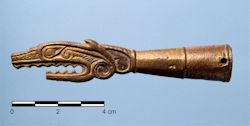
Drinking horns, for serving and consuming alcoholic drinks, are thought to have been an important piece of household equipment in societies where feasting and formal entertainment played a major role (see e.g. Etting 2013). The 7th-century heroic British poem Gododdin refers frequently to feasting and to the use of drinking horns for mead and wine (Youngs 1989, 62). Several of the sagas in Heimskringla (e.g. the saga of Harald Harfagre, Hakon The Good and Olaf Trygvasson) include vivid accounts of royal banquets where the use of drinking horns is mentioned (Etting 2013, 29). In Irish folklore, the possession and use of such items were the preserve of the elite, where status could be demonstrated by the ownership of a large number of horns, of horns displaying certain types or ornamentation, or even of famous named horns (Sørheim 2011, 21). A primary function of these prestige items was to 'enable their owners to demonstrate status by providing unlimited hospitality, an echo of the hospitality obligations mandated by the laws' (De Vagner 1995, 81-82). Finds of Insular drinking horns are, however, sparse and fragmentary; such items have mainly been found in Viking-Age graves in Norway and in unstratified contexts near settlements in Ireland (Sørheim 2011, 21). In addition, they are occasionally found in Norse burials in Ireland and Scotland (Redmond 2007, appendix 5).

In Norway, the remains of 24 Insular drinking horn vessels are known, and seven of these come from Trøndelag (Wamers 1985, plus recent finds). Three of the vessels are found in the old county of Namdalen, while the remaining examples are located within the Trondheimsfjord. The horn itself rarely remains, and the surviving evidence consisting mainly of the copper-alloy terminals and mount fittings and occasionally of suspension chains. Insular drinking horns have been found primarily in women's graves dated to the 9th century (Petersen 1940, 11). This is also the situation in Trøndelag, where only one example from Voll, Overhalla, comes from a man's grave. Drinking horns with zoomorphic terminals might have been specially valued for displaying status, and in Trøndelag five of the seven recovered examples display this type of ornamentation (De Vagner 1995, 83). One such terminal of particularly high quality has been found at Varøy, Nærøy (Figure 13). Also worth noting is the discovery of two drinking horn terminals from a cremation burial at Gjeite, Levanger, since this is one of only two graves in Norway where more than one such item has been recovered. The grave goods from Gjeite also included a large bronze cauldron of Insular origin. A similar combination of artefacts is known from a Viking-Age burial at Birka, Sweden, where two drinking horns and a glass vessel were placed inside a bronze cauldron. It has been suggested that these artefacts represent a drinking set (Trotzig 1984, 227-8), and it is possible that the Insular grave goods from Gjeite had the same function.
Internet Archaeology is an open access journal based in the Department of Archaeology, University of York. Except where otherwise noted, content from this work may be used under the terms of the Creative Commons Attribution 3.0 (CC BY) Unported licence, which permits unrestricted use, distribution, and reproduction in any medium, provided that attribution to the author(s), the title of the work, the Internet Archaeology journal and the relevant URL/DOI are given.
Terms and Conditions | Legal Statements | Privacy Policy | Cookies Policy | Citing Internet Archaeology
Internet Archaeology content is preserved for the long term with the Archaeology Data Service. Help sustain and support open access publication by donating to our Open Access Archaeology Fund.
File last updated: Wed Dec 3 2014